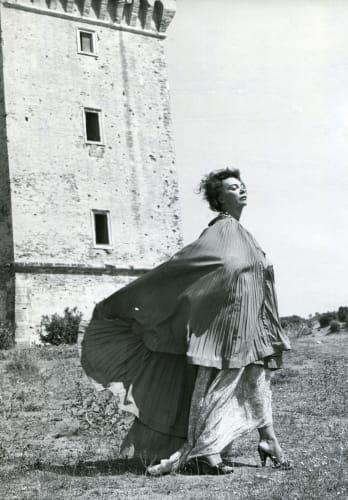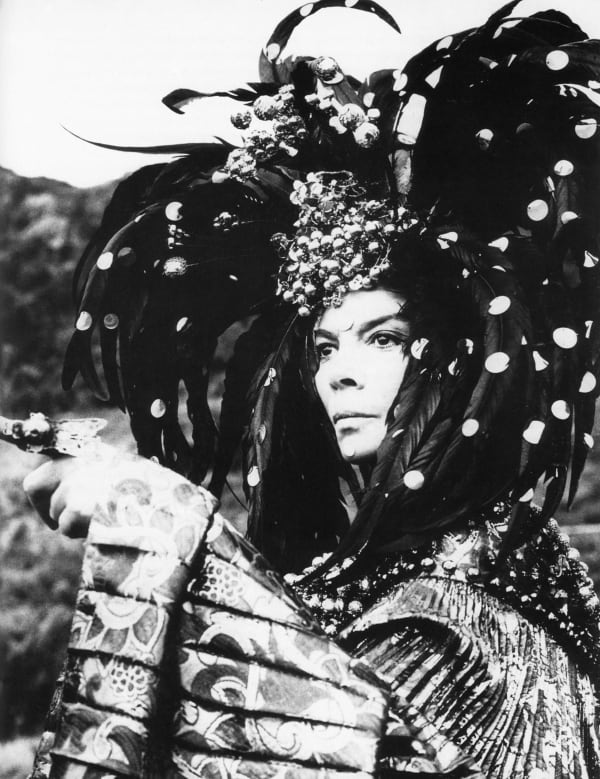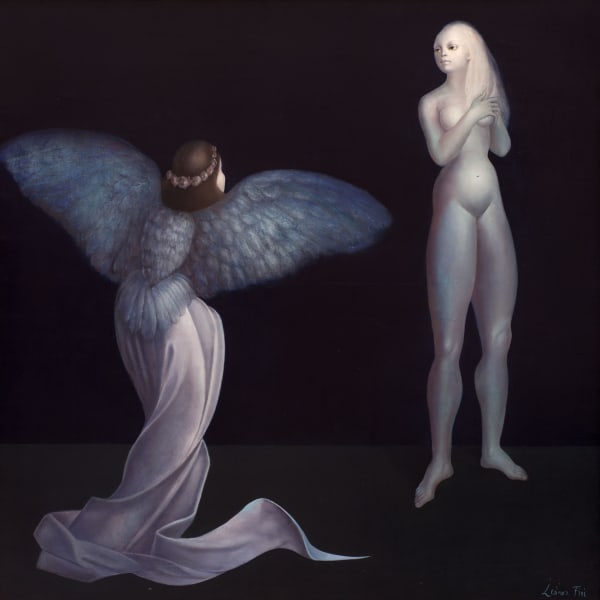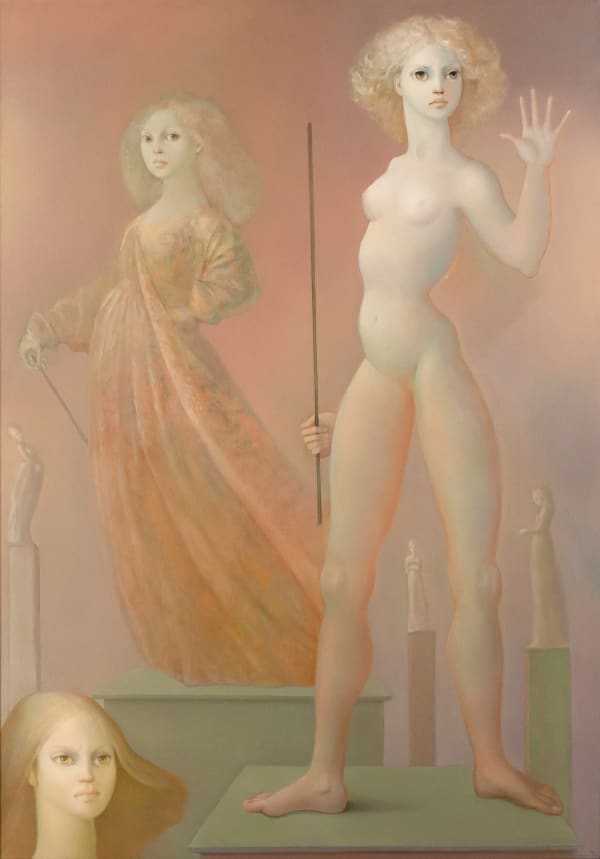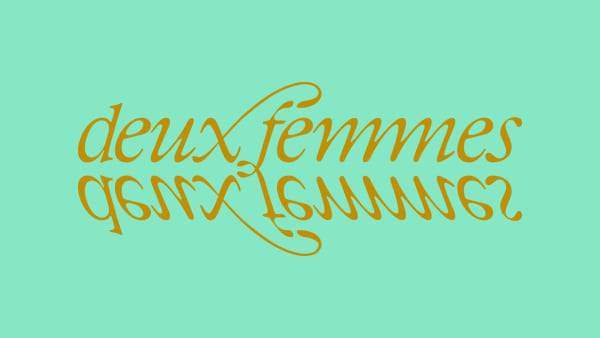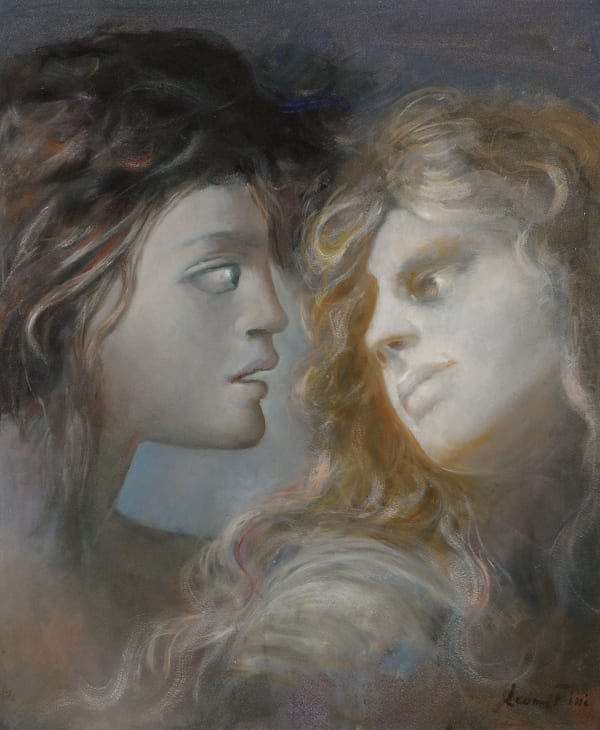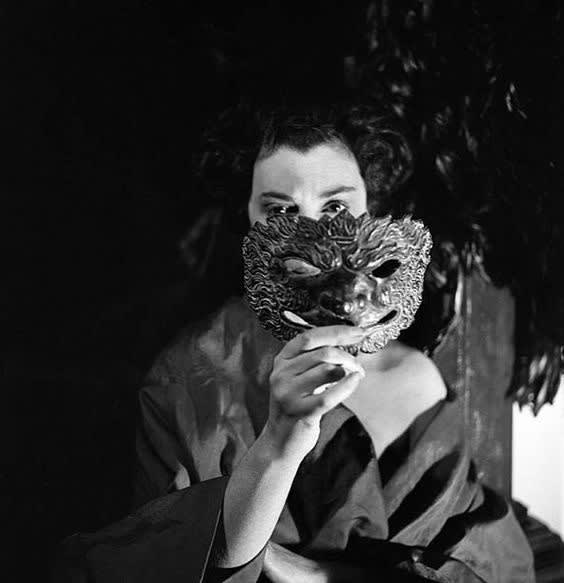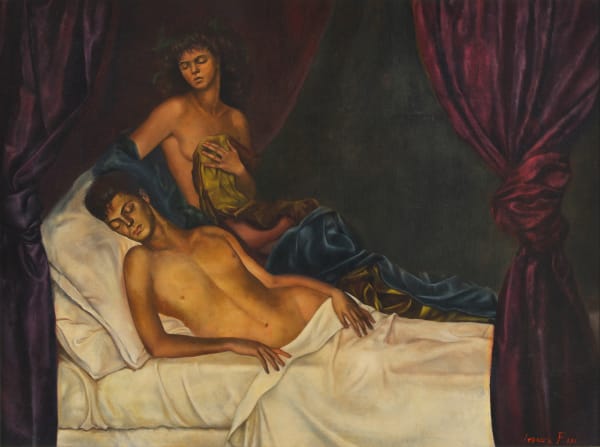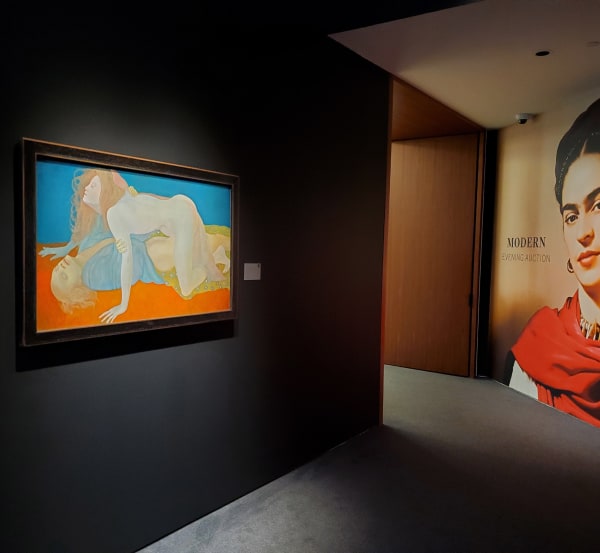A painting is something like a spectacle, a theater piece in which each figure lives out her part.
—Leonor Fini
The iconoclastic Leonor Fini was arguably the most ferociously and heroically independent woman artist of the 20th century. Fini herself never accepted the label of "woman artist," and likewise, never considered herself a Surrealist. She never sacrificed her independence to André Breton, the leader of the movement, and abhorred his misogynist views. Nonetheless, her works have been included in nearly every major Surrealism exhibition from 1936 to present. Fini was born in Argentina in 1907. Her mother spirited her away to her Italian homeland of Trieste. For the first seven years of her life, Fini was disguised as a boy whenever she left home to foil the kidnap attempts of her father. Raised by intelligent women and artistic personalities, it was not long before she decided to become an artist. By the time she relocated to Paris in 1931, she was already an intimate of Giorgio de Chirico and his circle. In Paris she was quickly 'adopted' by Max Ernst and the Surrealists that surrounded him. Fini became a sensation not only as an artist but also as a personality. She lived life like an actor in a play, creating a persona of drama, mystery and intrigue. The list of people she knew, collaborated with, or who were influenced by her over the following decades is itself a remarkable inventory of the thinkers and artists of the 20th century: Jean Cocteau, Man Ray, Leonora Carrington, Salvador Dalí, Joseph Cornell, Dora Maar, Anna Magnani, Albert Camus, Jean Genet, Federico Fellini, John Huston, and Georges Bataille, to name only a few. Fini came to incorporate many different lines of inquiry into her art. These were questions of beauty and age; of dark figures in conference that emerge out of murky waters and mottled landscapes; of an inexplicable silence that persists among those who attempt communication; and of the true nature of love and sex. Very few artists could be as simultaneously frank and enigmatic over a seven-decade career.
In a sense my paintings have always been my autobiography. A revealing autobiography because my paintings do not interpret either my conscious development or my experiences; rather, they ‘unmask’ a being inside of me (often with strange projections into the future).
—Leonor Fini
Leonor Fini (1907–1996) is considered one of the most important women artists of the twentieth century and also one of the most misunderstood. Frequently labeled a surrealist she was never a member of that group or movement, preferring to stake her own claim on modernism with a vision that owes more to the farthest shores of her imagination than to any affiliation with art trends, schools or movements. The originality of her art as well as her intelligence, famous wit and charisma accorded her celebrity status in the Paris art world and beyond beginning in the late thirties.
Often eclipsing and even compromising her standing as a major artist was the originality and impact of her personal style. Her panache and glamour, once they found a place in the collective imagination of the time, turned her into a much-publicized fashion and feminist icon. Always controversial, with as many detractors as admirers, she lived and painted consummately on her own terms. Not always in critical favor, her art continues to fascinate, captivate and is currently the source of an enthusiastic re-evaluation.
Born in Buenos Aires of mixed Spanish, Italian, Argentine and Slavic blood, Leonor was raised in Trieste by her single mother where she absorbed the multi-ethnic and mixed cultural heritage of that cosmopolitan center. If her formal education ended when she was an adolescent, she nevertheless traveled widely in Italy, visited many of the museums of Europe and read voraciously from her uncle’s large library. As a young woman she exhibited her paintings in Trieste and Milan, received commissions for portraits and formed close friendships with some of the leading Italian artists of the day.

In 1931, with an Italian prince who was her fiancé, she moved to Paris to forge a career as an artist. She quickly abandoned the prince, proclaimed her independence and formed friendships with Henri Cartier-Bresson, Salvador Dali, Max Ernst and the writer André Pieyre de Mandiargues who became her lover. She had her first one person show in Paris when she was twenty-five at a gallery directed by Christian Dior. Her work caught on fast and was included in the pivotal and groundbreaking Fantastic Art, Dada and Surrealism exhibition at the MOMA in 1936 while at the same time she had her first New York exhibition at the avant-garde Julien Levy Galley.
In Paris in 1939 she curated the inaugural exhibition of her friend Leo Castelli’s first gallery (of surrealist furniture) and shortly thereafter, just before the German occupation, she traveled with André and a new lover to Arcachon in the southwest of France to begin waiting out the war. She remained there for almost a year with Salvador and Gala Dali before moving to Monte Carlo where she met the young Italian diplomat, Stanislao Lepri who became one of the great and enduring loves of her life. As the war intensified she moved with Stanislao to Rome where she lived, worked and formed close friendships with Anna Magnani, Luchino Visconti and other leading figures of world of art and letters. After the Liberation of Paris in 1944 she returned there to live and work for the remainder of her life.
The predominant themes in Leonor Fini’s art are sexual tensions, mysteries and games. One of her favored subjects is the interplay between the dominant female and the passive male, and in many of her most powerful works the female takes the form of the sphinx to which she felt a strong identification. She was also a renowned portraitist, and among her subjects were such friends as writers André Pieyre de Mandiargues, Jean Genet, Klaus Mann (son of Thomas), such actresses as Anna Magnani and Suzanne Flon, ballerina Margot Fonteyn, film director Luchino Visconti and artists Meret Oppenheim and Leonora Carrington.
Her genius for stage and screen design is evident in her numerous ground breaking theater decors with their elaborate conception, costumes and phantasmagorical masks. She designed for the Paris Opera, George Balanchine’s ballet Palais de Crystal, and choreographer Roland Petit’s company Ballets de Paris, for Maria Callas at the La Scala theater in Milan, as well as over seventy productions at theaters in Paris between 1946 and 1969. She had a unique talent for film design and created costumes for Fellini's 8 ½ as well as for Renato Castellani's Romeo and Juliet and John Huston’s A Walk with Love and Death.
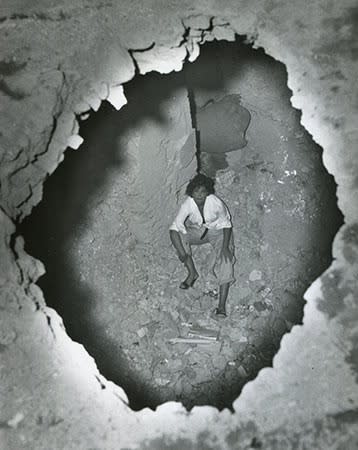
The provocative and much-publicized life of Leonor Fini was pure theater. Her story is that of a hard-won struggle to forge her life as a woman artist in a man’s world and to invent herself on her own terms. It is the story of a woman possessing exceptional independence, a highly original vision and great personal magnetism who lived passionately through her art and friendships and in the process became a feminist role model. As for her personal life, she is known for her unique design for living which was based on the practice of not parting company with ex-lovers but continuing to live with them even as new lovers moved in and took their place in her life. In spite of herself she thus gained a certain notoriety as being the originator and best known devotee of that modern practice which consists of a woman’s right to cultivate and nurture an in-house male harem.
The principal sources of the life of Leonor Fini are her biographies and monographs and also the Leonor Fini Archives, Paris, which house her personal papers and library.
Richard Overstreet, the author of this outline, is director of the Leonor Fini Archives. He is a painter and former assistant of such directors as Joseph Mankiewicz, Joseph Losey, Louis Malle, Anatole Litvak, Philippe de Broca and John Huston who introduced him to Leonor when he was first assistant on his film A Walk with Love and Death for which she was the costume designer.
Public Collections
-
The Metropolitan Museum of Art, New York, New York
-
Tate Modern, London, England
-
Peggy Guggenheim Collection, Venice, Italy
-
Centre Georges Pompidou, Paris, France
-
Musée d’Art Moderne de la Ville de Paris, France
-
California Palace of the Legion of Honor, San Francisco, California
-
The McNay Art Museum, San Antonio, Texas
-
Musée de Grenoble, France
-
Musée de l’Hospice Saint-Roch, Issoudun, France
-
Musée d’Art et d’Histoire, Geneva, Switzerland
-
Museo Revoltella, Trieste, Italy
-
Miyazaki Prefectural Art Museum, Miyazaki, Japan
-
Museum of Modern Art, Brussels, Belgium
-
Galleria Nazionale d’Arte Moderna e Contemporanea, Rome, Italy
-
Galleria Nazionale d’Arte Moderna, Museo Mario Praz, Rome
-
Galleria d’Arte Moderna e Contemporanea, Palazzo Massari, Ferrara, Italy
-
Opéra National de Paris, France
-
Art Institute of Chicago, Illinois
Selected Solo Exhibitions
-
Julien Levy Gallery, New York - Leonor Fini, with Max Ernst, catalogue with text by Giorgio de Chirico, poem by Paul Éluard, The Black Picture—for Leonor Fini (Le Tableau noir), November 18–December 9, private viewing November 17.
-
Julien Levy Gallery, New York, February 28–March 14.
-
Hugo Gallery, New York, text by André Pieyre de Mandiargues.
-
Palais des Beaux-Arts, Brussels, text by Paul Fierens, October 30–November 17.
Société des Beaux-Arts, Antwerp, text by Paul Fierens, January 22–February 2.
-
Société des Beaux-Arts, Antwerp, text by Paul Fierens, January 22–February 2.
-
Maisons des Loisirs, La Louvière, Belgium.
-
Galerie Vendôme, Paris.
-
Librairie Gasparin, Paris, exhibition of masks to mark the publication of Masques de Leonor Fini by André Pieyre de Mandiargues.
Shepheard's Hotel, Isis Room, Cairo, March 8; Lehman Gallery, Alexandria, March 20, with drawings by Stanislao Lepri.
Galleria dell'Ala Napoleonica, Palazzo Reale, Venice, text by Jean Cocteau, September 2–15.
-
Lausanne Palace, Lausanne; Musée d'Art et d'Histoire, Geneva, with Michèle Cascella, November.
-
Galerie Drouant-David, Paris, November 25–December 10.
-
Gallery Seventy-Five, New York, with Roland Bouvier.
Galleria Galatea, Turin, text by Luigi Carluccio, October 10–28.
-
Kaplan Gallery, London, text by Max Ernst, November.
Alexander Iolas Gallery, New York, text by Yves Bonnefoy, November.
-
Galerie Alexandre Iolas, Paris, text by Yves Bonnefoy, May 11–June 5.
Casino communal, Knokke-le-Zoute, XVIIIth Belgian Summer Festival, Retrospective, July–September.
-
Galleria Galatea, Turin, text by Luigi Carluccio, May 5–26.
Galerie Iolas, Geneva, text by Luigi Carluccio, December.
-
Hanover Gallery, London, talk at opening given by Stephen Spender, May 11–June 10.
-
Galleria Iolas, Milan, text by Luigi Carluccio, December 1967–January 1968.
-
Galleria Dantesca, Turin, text by Angelo Dragone, March 6–26.
Galeria Iolas-Velasco, Madrid, November.
-
Galleria Torbandena, Trieste, October 30–November 14.
Galerie Gmurzynska, Cologne, October 24–December 9.
Galerie Lambert Monet, Geneva, December.
-
Galerie Iolas, Geneva, gouaches, April 24–May 30.
Galerie Lambert Monet, Geneva, oil paintings, April 24–May 30.
Galerie Isy Brachot, Brussels, Rétrospective, text by Yves Florenne, June–August.
Centro Internazionale d'Arte “Il Poliedro,” Rome, Le Satyricon, December 14.
-
Palais de l'Athénée, salle Crosnier, Genève, Leonor Fini, maquettes de théâtre, March 5.
Galerie Hans Hoeppner, Hambourg, Leonor Fini, Paris, June 4–July 3.
Galerie Hans Hoeppner, Munich, Leonor Fini, Paris, July 931.
-
Knokke-le-Zoute, Belgium, December 1971–January 1972.
-
Galerie Lambert Monet, Geneva, Monsieur Vénus, June 15–July 20.
-
Seibu Muséum, Tokyo, Hanshin Museum, Osaka, Fukuoka Museum, Hiroshima Museum, Kanazawa Museum, Japan, Retrospective, text by Leonor Fini, to April 1973.
-
Galleria San Sebastianello, Rome, Monsieur Vénus, February 26–March 25.
Galleria II Fauno Due, Turin, December 12.
-
Palais de la Méditerranée, Nice, exhibition organized by the Galerie Lambert Monet, Geneva, 7 January–31 March.
Galerie Altmann Carpentier, Paris, Oeuvres récentes, November 26–December 27.
-
Galerie Altmann Carpentier, Paris, Le Livre de Leonor Fini, November 27, 1975–January 31, 1976.
Galerie Proscenium, Paris, Images pour le théâtre, December 3, 1975–January 1976.
-
Musée d'Art Moderne de Latem, Sint-Martens-Latem, April–March.
-
Galerie Carpentier, Paris, Sultanes et Magiciennes des Mille et Une Nuits, December 2, 1976–January 15, 1977.
-
Château de Vascoeuil, Normandy, text by Constantin Jelenski and Jean Bouret, May 28–October 2.
Town Hall, Nonza, Corsica, August.
-
Musée d'Art Moderne de Latem, Sint-Martens-Latem, Belgium, text by Marcel Paquet, April 16–May 15.
Musée d'Angers, Angers, 4th Festival d’Anjou, L’Autre theater de Leonor Fini, text by Jean Bouret, June 22–August 31.
Town Hall, Nonza, Corsica, Leonor Fini - Stanislao Lepri, August 16–26.
La Galerie des Arts Plastiques Modernes, Paris, November 22–December 20.
-
Galerie Proscenium, Paris, Fruits de la Passion.
-
Casino-Kursaal, Ostend, Belgium, text by Jos Murez: Le Thème du dédoublement dans l’œuvre de Leonor Fini, June 15–August 28.
-
Musée Ingres, Montauban, April 22.
Museum Villa Franz von Stuck, Munich.
-
Galerie Proscenium, Paris, Les Petites Enseignes pour la nuit, November 9–December 31.
-
Galleria Civica d'Arte Moderna, Palazzo dei Diamanti, Ferrara, Retrospective, July 2–September 30.
-
Sogo Museum of Art, Yokohama, Daimaru Museum of Art, Osaka, Municipal Art Museum, Kitakyu-shu, Hokkaïdo Museum of Modern Art, Sapporo, Japan, Retrospective, text by Leonor Fini and Constantin Jelenski, November 22, 1985–May 11, 1986.
-
Musée du Luxembourg, Rétrospective, June 17–July 16.
-
Galerie Proscenium, Paris, Visages, December 4, 1986–January 24, 1987.
-
Galerie Guy Pieters, Knokke-le-Zoute, Belgium, May 1–29.
Galerie Carpentier, Paris, Baudelaire-Poe, June 8–July 29.
-
Mairie de Nonza, Corse, August 6–15.
-
Galerie Dionne, Paris, Les Passagers, June 11–July 31; October 1–December 15.
Maison du Loir-et-Cher, Blois, June 1–30.
-
Alliance Française, San Francisco, Depth Set Free, organized by Tristan Dubois, Dubois Fine Art, February 3–27.
Kunsthaus Dr Hans Hartl, Freising, Germany, February 5–April 4.
Town Hall, Nonza, Corsica, Leonor Fini-Stanislao Lepri, August.
Chateau de Rivieren, Belgium, October 29–November 1.
-
Galerie Dionne, Paris, Oeuvres récentes, November 30, 1994–February 28, 1995.
-
Galerie Arcade Colette (Palais Royal), Paris, December 6–23.
-
Galerie Arcade Colette (Palais Royal), Paris, February 20–March 7.
Galerie Richard P. Hartmann, Munich, In memoriam Leonor Fini, April 2.
-
Galerie Dionne, Paris, Les Somnambules—In memoriam Leonor Fini, March 12–June 28.
Château de Vascoeuil, Normandy, Oeuvres de 1925 à 1995, July 6–October 19.
Maison de la Loire, Saint-Dyé-sur-Loire, Leonor Fini - Stanislao Lepri, July 11–September 6.
-
Panorama Museum, Bad Frankenhausen, Germany, Leonor Fini, peintre du fantastique, Rétrospective, November 22, 1997–March 1, 1998.
-
Lavoir Charles Vasserot, Saint-Tropez, July 3–23.
Town Hall, Saint-Mandé, France, October 18–November 18.
-
Palexpo, Geneva, Salon International du Livre, de la Presse et du Multimédia, April 27–May 1.
-
Weinstein Gallery, San Francisco, December 6, 2001– January 29, 2002.
-
Malmaison, Cannes, Leonor Fini, Portraits, February 23–May 5.
-
Exposition Leonor Fini, Bunkamura Museum of Art, Tokyo, June 18–July 31, 2005; traveled: Daimura Museum, Umeda, August 31–September 11, 2005; The Museum of Modern Art, Gunma, September 23–November 3, 2005; Nagoya City Art Museum, Nagoya, November 11–December 25, 2005.
Leonor Fini alla Scala, Museo Teatrale alla Scala, Milan, (designs for productions of ballets and operas by Leonor Fini at the Teatro alla Scala), November.
Weinstein Gallery, San Francisco, “Weinstein Gallery Celebrates the Japanese Museum Tour,” August.
-
L’Atelier Grognard, Rueil-Malmaison, Métamorphoses d’une femme, November 17, 2006–January 22, 2007.
-
Musée de l’Hospice Saint Roch, Issoudun, France. Exhibition and inauguration of the permanent installation of the “Salon de Leonor Fini,” February 8.
Weinstein Gallery, San Francisco, Leonor Fini, Paintings & Works on Paper–Recent Acquisitions, July.
-
Revoltella Museum of Modern Art, Trieste, Leonor Fini, L’italienne de Paris, retrospective exhibition, July 4–September 27.
Weinstein Gallery, San Francisco, Leonor Fini: A Retrospective, November.
-
Bildmuseet, Umea, Sweden, Leonor Fini / Pourquoi Pas?, January 31, 2014–May 11, 2014.
-

Leonor Fini: Theater of Desire, 1930-1990 at the Museum of Sex
Press & Reviews, Sep 28, 2018 -

Leonor Fini @ Weinstein
Square Cylinder, Nov 23, 2015 -

How To Be A Surrealist Queen, According To Artist Leonor Fini
Huffington Post, Nov 13, 2015 -

Wild imaginings in the galleries
Bay Area Reporter, Nov 11, 2015
-

Rendevous of Dreams at Hamburger Kunsthalle
June 13, 2025 - October 12, 2025One hundred years ago, the most renowned artistic movement of the twentieth century emerged in Paris: Surrealism. Sparked by a reconsideration of value systems in...Read more -

Io sono LEONOR FINI @ the Palazzo Realé
February 26, 2025 - July 20, 2025Leonor Fini fits into the Palazzo Reale's long history of presenting exhibitions on Surrealism and artists related to the movement, as well as its ongoing...Read more -

Leonor Fini Les Stylistes sells for $720,000 at Sotheby's New York
The Art Newspaper Nov 19, 2024'...A trio of women Surrealist artists sparked some of the early action with Remedios Varo's fantasy figure of a bicycle bodied woman, Los caminos tortuosos...Read more -

$65.5 Million Monet Sells at Sotheby's New York, While $12 Million Matisse Flops
Artnet Nov 18, 2024'Surrealist women continued their triumphant rise, and those who have believed in them reaped rewards. A haunting sculpture by Leonora Carrington, La Grande Dame (The...Read more -

Leonor Fini Rogomelec sells for £907,200 at Christie's
Read at The Art Newspaper Oct 9, 2024'..Demand was also strong for quality Surrealist works. Magritte's Le grand style (1951) exceeded its estimate at £2.1m (£2.6m with costs), and Leonor Fini's Rogomelec...Read more -

An Expansive New Surrealism Show Celebrates 100 Years Of Artistic Revolution
Artnet Oct 4, 2024Featuring more than 500 objects, the Centre Pompidou's 'Surrealism' show explores the global reach and diversity of the artistic movement. Between the rise of artificial...Read more -

Orange County Museum of Art Features Carrington & Fini in Deux Femmes
September 12, 2024 - April 6, 2025Deux Femmes Deux Femmes brings together a collection of work by artist Leonor Fini (b. 1907, Buenos Aires, Argentina; d. 1996, Paris, France) and Leonora...Read more -

State of the Art Market: Surrealist Women Awakening
ARTNET Dec 13, 2023With most historical art movements, we find that there are scores of women whose influence and work have been overlooked or at the least undervalued...Read more -

Surrealist Leonor Fini makes a Miami Beach splash
The Art Newspaper Dec 7, 2023Amid surging interest in women Surrealists, Galerie Minsky and Weinstein Gallery devoted their joint stand to the Argentine painter One of the buzziest stands at...Read more -

'She was a pure creator.' The art world rediscovers Surrealist painter Leonor Fini
NPR Dec 7, 2023An overlooked female artist is starting to get her due. Nearly 30 years after her death, Leonor Fini's captivating, often gender-bending images are attracting renewed...Read more -

Judy Chicago "Herstory" at the New Museum
Oct 12, 2023 - March 3, 2024 Nov 28, 2023“Judy Chicago: Herstory” will span Judy Chicago’s sixty-year career to encompass the full breadth of the artist’s contributions across painting, sculpture, installation, drawing, textiles, photography,...Read more -

Leonor Fini Fabrizio Clerici - Insomnia at MART Rovereto
July 16 - Nov 5, 2023 Nov 28, 2023Commemorating the long and close relationship between Leonor Fini and Fabrizio Clerici is the immense exhibition at the Mart di Rovereto, curated by Denis Isaia...Read more -

Leonor Fini returning to the limelight
Artprice Jul 25, 2023At a time when collectors favor figurative art with a Surrealist tendency and when women artists are the focus of all attention, the work of...Read more -

Klimt’s ‘Lady With a Fan’ Sets a New Auction Record in Europe, Making $108.4 Million at Sotheby’s Mini-Marathon of London Sales
ARTNET Jun 27, 2023..Other highlights included Jenny Saville’s Shadow Study (2006–07) which sold for £3.4 million ($4.4 million). The work previously came to auction in 2014, when it...Read more -

5 Late LGBTQ+ Artists Finally Getting Their Due
Artsy Jun 9, 2023LGBTQ+ artists have long been excluded from popular narratives and public recognition both in art history and the art market. But in recent years, as...Read more -

How a Broadway Producer Recreated Peggy Guggenheim’s Groundbreaking ‘Exhibition of 31 Women’ on Its 80th Anniversary
ARTNET May 18, 2023'I was a liberated woman long before there was a name for it,' art doyenne Peggy Guggenheim once remarked. Indeed, the trailblazing collector and socialite...Read more -

Leonor Fini featured in Neo-Romantics at Musée Marmottan Monet
March 8 - June 18, 2023 May 5, 2023More than one hundred works, from private and public collections, are brought together to (re)discover one of the first post-modern movements based on the questioning...Read more -

Surréalisme au Féminim? at the Musée de Montmarte
March 31 - September 10, 2023 May 5, 2023The exhibition Surréalisme au Féminin? will be presented from March 31 to September 10, 2023 at the Musée de Montmartre Jardins Renoir. Visit the exhibtion...Read more -

The Late Women Artists Garnering Art Market Attention
Artsy Mar 8, 2023In 2022, we saw incredible strides for women artists across museum exhibitions, galleries, art fairs, and auctions. A prime example was the historic international exhibition...Read more -

Frieze Tate Fund Acquires Works for the National Collection at Frieze London and Frieze Masters 2022
Frieze Magazine OCT 2022Supported by Endeavor, Tate acquires pieces by Romany Eveleigh, Leonor Fini, Lewis Hammond, Rita Keegan, Sandra Vásquez de la Horra and Frida Orupabo at this...Read more -

Fini Featured in 5 Modern Women Artists to Know
Daily Art Magazine MAR 2022When we think of modern women artists, certain names immediately come to mind. For instance, anyone can name Frida Kahlo , and the more well-read...Read more -

Leonor Fini: I’m Not a Muse, I’m an Artist
Daily Art Magazine SEPT 2022Read at Daily ARt MagazineRead more -

Under a revolutionary, emancipatory spell: Venice exhibition explores Surrealism’s interest in the occult
The Art Newspaper APR 2022Major show at the Peggy Guggenheim Collection includes works by leading lights of Surrealism, including Leonora Carrington and Dorothea Tanning Waiting for their visas to...Read more -

Surrealism and Magic: Enchanted Modernity Co- Curator, Gražina Subelytė Interviewed
Christie's MAR 2022As the exhibition Surrealism and Magic: Enchanted Modernity opens in Venice, its curator Gražina Subelytė talks to Christie's about the role of the occult in...Read more -

With a Majority-Female 2022 Edition, the Venice Biennale Will Make History for Women Artists
ARTnews FEB 2022Since it started in 1895, the Venice Biennale has been an every-other-year barometer of the global art world. As such, the release of its artist...Read more -

Time capsules, more women and a room for Paula Rego: curator Cecilia Alemani reveals her plans for this year’s Venice Biennale
The Art Newspaper FEB 2022The artistic director of the 2022 Venice Biennale, Cecilia Alemani, outlined today at a press conference her curatorial plans for the 59th International Art Exhibition,...Read more -

Leonor Fini’s Les Aveugles (1968) finds success at Sotheby's Impressionist and Modern Evening Sale
ARTnews Nov 16, 2021Following the record sale of the Kahlo, lots by female Latin American surrealists also found success on Tuesday. Leonor Fini’s Les Aveugles (1968), which depicts...Read more -

We Asked 10 Art-World Insiders Which Artists They’re Most Excited to Watch Over the Next Decade. Here’s What They Said
Artnet OCT 2021...Brooke Lampley, Sotheby's chairman and worldwide head of sales for global fine art, New York I'm excited about the continued market reappraisal of female artists....Read more -

Leonor Fini’s Autoportrait au scorpion sets a new auction record at $2,319,000
Sotheby's May 12, 2021Leonor Fini’s arresting Autoportrait au scorpion , the only self-portrait the artist chose not to sell in her lifetime, set a new auction record for...Read more -

Leonor Fini, Alice Rahon and Remedios Varo paintings set new auction records
Artsy Jun 30, 2020The first major test of the upper echelons of the secondary market since COVID-19 shut down most of the world’s auction house salesrooms was, by...Read more -

Surrealism Was a Decidedly Feminine Movement. So Why Have So Many of Its Great Women Artists Been Forgotten?
Artnet Feb 18, 2020Female artists’ contributions to the Surrealist movement may be well known, but only a handful have received the recognition they deserve. A scholarly new exhibition...Read more -

Leonor Fini's long-awaited catalogue raisonné now available
Feb 21, 2019Leonor Fini Catalogue RaisonnéRead more -

Leonor Fini / Pourquoi pas at Bildmuseet
Feb 2, 2014The exhibition Leonor Fini / Pourquoi pas? highlights the diversity of Leonor Fini’s expression and presents paintings, drawings, objects, book illustrations, literature as well as...Read more


